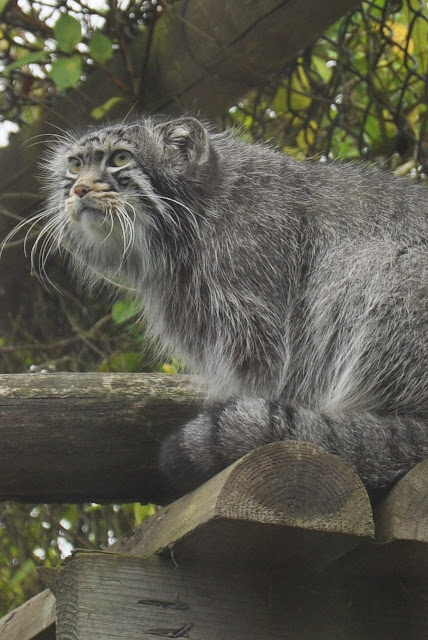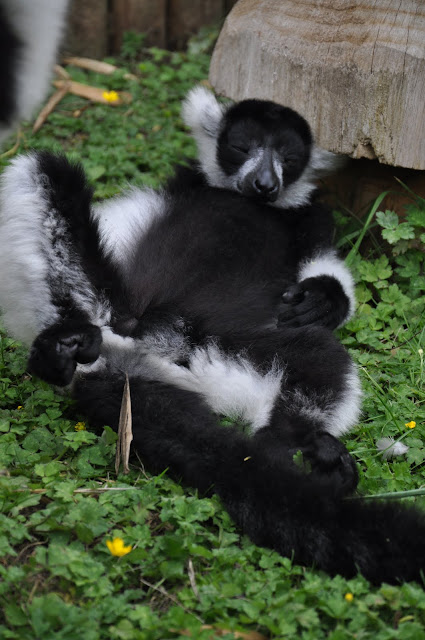On our last full day in Kent we headed to Howletts Wildlife Park - the home of rare and vulnerable species. John Aspinall founded Howletts and now it is run by his son, Damian Aspinall. It is not a conventional zoo.
The aim of the Howlett Foundation is the long-term survival of endangered species. Howletts has also been involved in a number of re-introduction projects.
The park is a delight. We did not see all the animals that they have here - some were hiding in their large enclosures and others kept themselves quite some distance from prying eyes. This is how zoos should be with ample space for the animal to decide what he wants to do in his enclosure rather than being forced through lack of space to confront the enclave surrounding its cage.
The above is a Bongo. They can be found in the dense forest areas of West, Central and East Africa. They have beautifully marked brown coats which have 12 to 14 narrow white stripes which provides perfect camouflage. They are critically endangered.
We came across Balck and White Colobus Monkeys. They were very entertaining! This monkey above had a young one - see below. She was trying to do her best to keep the baby with her but the baby had other ideas! The dad was some distance away and was observing how the litttle one was behaving. Having watched for some time and seeing the difficulty mum was having in reining the young one in, he galloped at speed across the enclosure, grabbed the baby and shook him before handing him back to mum. The baby stayed put after that telling off!
Here's the naughty little monkey! The behaviour was so like that of children and the mum and dads reaction was very human too! Mum exasperated and dad coming to the rescue. Both doing their best to bring up their young one to be respectful and to do as they're told!
Here's mum trying to keep the little one under control. He tries to dart from her grasp!
Doesn't the look on mum's face seem say it all - "I've had enough of this larking around! Behave yourself!"
Oh, please help me - this little one is out of hand and very strong willed!
We came across African Hunting Dogs. These live on the Savannah plains and in the mountains of sub-Saharan Africa. They usually live in packs of up to eight adults. The dominant female produces 7 - 10 pups. After they have been weaned they are then looked after by the pack until they are about a year old.
We saw a Pallas Cat. They originate from the desert and rocky mountainside of Russia and Central Asia.
The Howletts booklet stated that they are shy cats. If so, this one was certainly the exception to the norm as it posed nicely for a number of shots!
It even yawned as if bored by our presence!
Before looking directly at us! Isn't it cute!
We went to the lemur enclosure. I didn't realize that lemurs are critically endangered. The destruction of the forest in Madagascar has led to one-third of the lemur species becoming extinct. A bad indictment on what we humans do to our environment.
Our Daughter in the lemur enclosure - look at how trusting they are to think what we have done to their habitat!
They eat fruit, seeds and leaves.
This one was completely chilled!
We came across the tigers.
Such beautiful animals. How can people kill them just for the sake of a fur coat beats me.
Out of all wild animals - the big cats are my favourites, followed closely by elephants.
We came across the Red River Hog. They live in the forest and grassland of sub-Saharan Africa and Madagascar. It is not welcome in its homeland as groups of them raid crops at night and tear up vegetation in their search for roots, bulbs, tubers and fallen fruit.
Look at their enclosure - barren from all their efforts.
Strange looking animals!
Finally, we came across the elephants!
In the 1970's and 1980's demand for ivory caused a disastrous decline in the African elephant population - it is estimated that the population fell from 1.3 million to 600,000.
How could people kill these wonderful animals just for their tusks!
We stayed at the Park until closing time before heading back to Whitstable.
During the early part of the evening we made our way to Reeves Beach to see the Blessing of the Waters.
This is an annual event which takes place as near as possible to the Feast Day of St. James, the patron saint of oystermen - to appease the cruel sea and to give thanks for its bounty. This tradition dates back to 1657!
Here are members of the clergy and Mayor heading towards the sea.
After observing the blessing we walked into Whitstable town centre and to a local Indian restaurant for some food.
We then walked back to the house via the seafront and observed all the grotters that had been built with empty oyster shells in the afternoon all lit up.
There were many grotters and some had been beautifully decorated.
Many of the restaurants on the beach front were open. We had tried to book a table here as it was out last night but many people had got there before us - hence our trip to the Indian!
All too soon we arrived back at the house and had to begin packing ready for our early departure in the morning.
Good-bye Whitstable - we hope to be back soon!
Until next time,
June.



























No comments:
Post a Comment
Please do leave a comment. I love to hear from you!